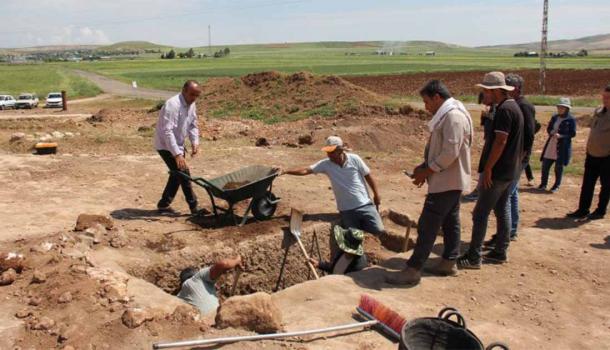
2,000-Year-Old Tomb Found in Tharsa Was Guarded by Bulls
In the ancient city of Tharsa in modern day Turkey, archaeologists have discovered a 2000-year-old tomb adorned with two bull heads during excavation and cleaning efforts. Now known as Turuş Rock, the tombs are located near Kuyulu village on the Adıyaman-Şanlıurfa Highway.
This collection of tombs is not knew, and they are known as the Turuş Rock Tombs. Excavations started last year in 2021 in the ancient city, where a family cemetery is known to be located.
Belonging to the Roman Period, the Turuş Rock Tombs were carved into the bedrock from the ground downwards. These tombs are accessed by descending 10-13 steps. Various figures and reliefs decorate the walls and doorways of some of these rock tombs, according to Anatolian Archaeology.
- Roman Tombs Found in Egyptian Oasis Reflect Cultural Blending Evident in Burial Practices
- Will Aurochs, a Cattle Species Found in Ancient Cave Paintings, be Resurrected?

The rock-cut tomb containing the bulls is one of many in the ancient Tharsa cemetery (IHA)
But the most striking find has to be the two large bull heads which flank the entrance to a tomb, staring out at interlopers from eternity.
The Bull and the Divine
Archaeologists believe the bull heads were included in the grave to help cleanse the grave's owner of evil spirits. In Roman culture, the bull, symbolic of the god Jupiter, represented power, strength, and unpredictability.
Additionally, it was a symbol of the city of Athens, depicted on many Athenian coins to signify the city's strength and power. In Roman coinage, the bull symbolized strength and fertility and was associated with the god Mars.
Such an association was understandable. Classical bulls were seen as formidable and powerful creatures, particularly in the form of the ancient and extinct aurochs. This lost bovine species was a huge and wild cousin to modern cattle, dangerous and immeasurably strong. The bull's robust and formidable presence on coins signified the might and resilience of the Roman and Athenian states, projecting an image of enduring power to both its citizens and its adversaries.
- The Tomb of Lyson and Kallikles: A Roman-style Macedonian Grave?
- Mithras, the Persian God Championed by the Roman Army

Close up on the bulls in the Tharsa tomb (IHA)
Mustafa Çelik, Deputy Director of Adıyaman Museum, said, “Tharsa Ancient City consists of 3 main archaeological areas: Big Mound, Small Mound and Necropolis Area. We started excavations in the necropolis area in 2024. We added 2 more rock tombs to the rock tombs we had previously uncovered. One of them is the rock tomb we identified today.”
The tomb, consists of a main chamber and three arcosolia, and is adorned with two bull's head figures, known in ancient times as bucrania, on the upper part of the entrance. Between these bull heads, there are decorative elements called garlands and rosettes.
In the context of Roman tombs, bucrania held particular significance, as they were considered a protective force with purifying powers. This association imbued the bull with a divine aspect, suggesting that its presence could safeguard the deceased from evil spirits and ensure a peaceful transition to the afterlife.
The archaeologists are now actively working to develop this area into a significant center of attraction for tourism, he further explained, reports Arkeonews.
Roman Funerary Practices and Tharsa
Roman funerary practices encompassed a variety of rituals and customs that evolved over time, reflecting shifts in religious beliefs and social norms. In the early Roman Republic, cremation was the predominant method of disposing of the dead, with funeral pyres used to burn the body and collect the ashes in urns. However, as the Roman Empire expanded and absorbed diverse cultures, including those with different burial traditions, inhumation gradually became more common, particularly from the 2nd century AD onwards.
Funeral rites were an integral part of Roman funerary practices, often beginning with a solemn procession to the burial site, reports The Smithsonian. These processions, which could be elaborate affairs, included family members, friends, and sometimes professional mourners who lamented the passing of the deceased.
Wealthier families might hire musicians or display ancestral masks (imagines) as part of the procession, emphasizing the lineage and status of the deceased. Once at the burial site, various rituals and offerings were performed to honor the departed and ensure a smooth transition to the afterlife.

Excavation work at the site is ongoing and it is hoped the cemetery will yield more ancient surprises (IHA)
These rites were influenced by Roman religious beliefs and traditions, as well as by cultural practices inherited from conquered territories.
The ancient city of Tharsa, already home to 60 previously unearthed graves, continues to yield new discoveries. Excavations in the necropolis area, which began in 2024, have recently revealed two additional rock tombs. Museum Director Mehmet Alkan, who carried out the first excavation in 2021 had revealed that 60 family graves had been found in the area.
Top image: The two bull heads guarding the tomb in Tharsa are accompanied with garlands, in an arrangement known as bucrania. Source: IHA.
By Sahir Pandey
References
Anderson, S. 2024. In This Ancient Cemetery, Romans Left Fine Glass Vessels, Platforms for Feasting and Phallic Pendants. https://www.smithsonianmag.com/smart-news/in-this-ancient-necropolis-romans-left-fine-glass-ossuaries-platforms-for-feasting-and-phallic-pendants-180984232/
Buyukyildirum, O. 2024. 2000-year-old tomb guarded by two bull heads found in Tharsa Ancient City, Türkiye. Available at: https://arkeonews.net/2000-year-old-tomb-guarded-by-two-bull-heads-found-in-tharsa-ancient-city-turkiye/















